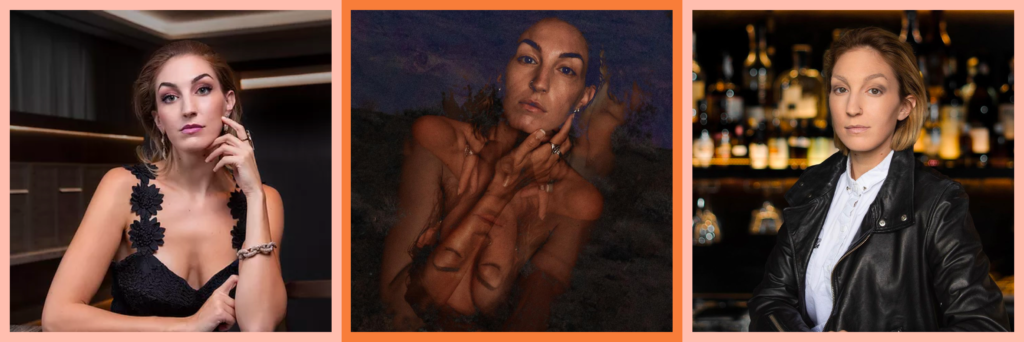In the first of what is to be a series of interviews with female founders and business women, we sat down over Tacos with Sarah Marcella, of Sarah Marcella Creative, to discuss her journey to owning her [thriving] business and get some advice on how your professional headshots can communicate your business and professional persona in an impactful way.
Sarah Marcella Creative is a photography & graphic design business based in Washington DC. With over 10 years of experience in the industry, she specializes in portraits, commercial, editorial and fitness photography. She is known for her vibrate imagery and energetic, positive personality.
Sarah ventured out on her own to open her photography business in 2015 and has won numerous awards for her work in the Alexandria area. But like all of us, it originated with a journey to gain confidence in herself to give it a go on her own.
What made you go out on your own?
Prior to starting the company I had worked retail for several years. I went to college for photography, but it was a conceptual art school so I was very much on my own to figure out taxes, how commercial photography worked in general, and how to run a business. It was very much a, “fake it till you make it,” experience in the beginning. I was over retail and I had a great community here [in Alexandria], which helped me gain the confidence to go out and do my own thing.
What differentiates your business from your competitors?
I am not the best photographer, by that I mean I might not be the most technically proficient person in the business. But, I have a personality that makes absolutely anyone feel comfortable in front of a camera, and that has taken me further than anything else. I would say the most important thing as a business woman/business person is to realize that your best asset is being a people person, because then genuine networking comes naturally and it’s not a forced chore.
When you were doing our headshots and company photos, you guided us through discussions of backdrops, etc. in a way I had never put much thought into for professional headshots before. How does the setting reflect the subject in the context of professional headshots and photography for people across different industries?
What is more important for a headshot than showing physically who someone is, is showing their personality. In a way that people see you and feel like they can imagine meeting you and what you might be like in person. Aside from getting people comfortable in front of a camera, the backdrop is a large part of that.
For the tech industry, I always try to use a modern backdrop— so either very geometric, or modern architecture. I like the United States Patent & Trade Offices for tech industry headshots because it’s this beautiful glass building and it feels very innovative– as I would imagine the architect intended, knowing what office it was home to.
Greenery can be blurred out while still maintaining interest, and make the subject pop— it works really well for real estate agents. For a yoga instructor I would want to put them in a field at sunset or a similar setting that feels very peaceful. A profession like an attorney I would much rather shoot with more traditional brick buildings where it feels strong, structured, and reliable.
Do you ever have people within a similar industry who are targeting very different audiences with their headshots? And if so how might you use the setting to appeal to those different targets?
Definitely, if we were to use the medical field as an example, all of our doctors go through extensive schooling and they have a similar background and core knowledge base, but a brain surgeon needs to speak to an audience with very different concerns than, say, a fertility specialist.
A surgeon I would want to put in a very sterile environment, potentially an actual operating room or somewhere with a lots of steel and clean lines. Being personally approachable is probably not the primary concern of someone researching their brain surgeon, you want them to almost be robotically precise in their expertise, and that feeling or impression can be communicated through the setting of their headshots.
On the other side of that you have medical professionals whose practice thrives on their bedside manner and their ability to empathize with patents. A fertility specialist for example is invited into a very personal and private element of a person or couple’s life, and those people are not only medically but emotionally vulnerable to that doctor by the nature of the care. A professional like that I would want to photograph in a very warm or inviting space, perhaps even a waiting room with lots of natural light. A space that reflects the natural body and personal connection in a way that surgery doesn’t.
So now that you’ve given us a lot to think about for our professional image: as a business owner of at least 5 years, what is one thing you wish you knew starting out that you would pass along to someone at the beginning of their entrepreneurship journey?
No one cares as much as you think they care. Just do the damn thing. I used to stress out so much and edit photos as soon as I got home to deliver them within 24 hours, at the cost of not taking care of myself. I became and was consumed by my business, which is not healthy for you and realistically not sustainable. Setting up standards and timelines for yourself and your clients that are sustainable and realistic is really important for long term success. If you burn out from lack of self care, and you are your business as many startups are in the beginning, then your business is burned out. Taking care of yourself and making that a priority might seem selfish or unfocused, but can actually be the difference between success or not for the long term.




